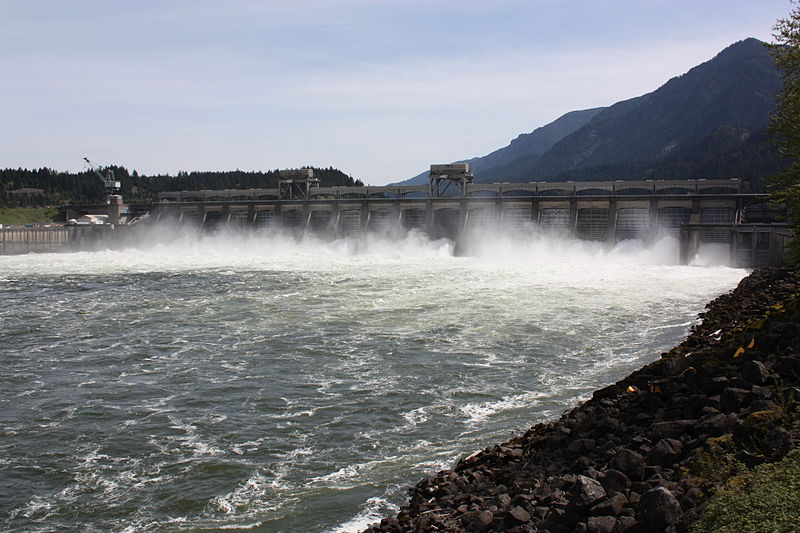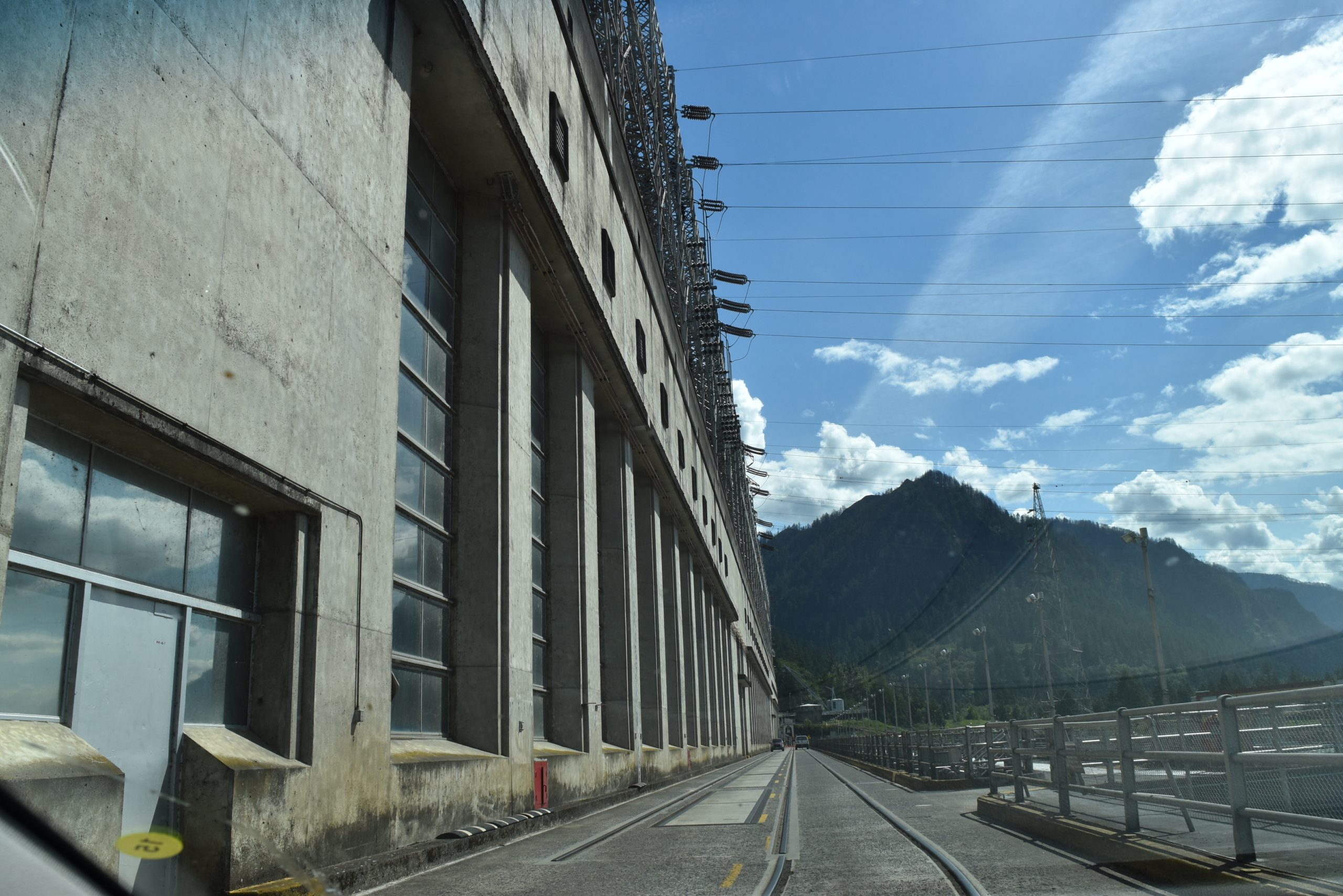- City:
- Bonneville, OR
- Site Type:
- Infrastructure and Utilities, Electricity
- New Deal Agencies:
- Army Corps of Engineers, Federal & Military Operations, Public Works Funding, Public Works Administration (PWA)
- Started:
- 1934
- Completed:
- 1938
- Quality of Information:
- Very Good
- Marked:
- Yes
- Site Survival:
- Extant
Description
Dams on the Columbia River for hydropower, navigation and irrigation had been eyed by Northwestern industrial, shipping and agricultural interests well before the New Deal. The Army Corps of Engineers published a report in 1929 that recommended ten dams on the river and the Bureau of Reclamation also had plans for irrigation development upstream, called the Columbia Basin Project. The Roosevelt Administration supported both agencies in their pursuits; with funds from the Public Works Administration (PWA) the two anchor dams, Bonneville and Grand Coulee, were begun in 1934.
Bonneville lock and dam were built by the Army Corps of Engineers and completed in 1938. It consists of four structures that together span the Columbia River at Mile 146, 40 miles east of Portland in the Columbia River Gorge. At that site, the river splits into three channels around three islands. The principal dam lies in the central channel. The original powerhouse and navigation lock are situated in the south channel and a second powerhouse in the north channel. The latter was completed in the 1980s.
The primary function of Bonneville Dam is electric power generation, with the electricity sold around the Northwest by the special purpose Bonneville Power Administration (BPA). Improved river navigation was a secondary purpose and is served by the two locks on the southern flank of the first powerhouse.
The dam’s construction provided jobs and economic stimulus to the Pacific Northwest. It employed 3,000 workers in three eight-hour shifts, who were paid 50-cents an hour. Local roads were improved and the cement industry prospered. Most important, the massive new supply of hydroelectricity – the cheapest in the nation – gave rise to a strong aluminum industry (ruins of an old Alcoa plant can still be found upstream from the dam), which led, in turn, to the location of the great Boeing aircraft works in Seattle WA. Cheap aluminum was critical to the American production of airplanes for World War II up and down the West Coast.
The final report of the PWA describes the construction of Bonneville Dam as follows:
“The dam has a concrete gravity base above which rise reinforced concrete piers 10 feet wide, spaced to provide 18 gates each 50 feet wide, making the total length of the dam proper 1,090 feet. The width at the base is 200 feet and the height above the lowest foundation is 170 feet. The dam is surrounded by a service roadway. The spillway is designed to pass a flood of 1,6000,000 second-feet. The steel gates are structural steel riveted construction with roller bearings and are operated by either of two 350-ton gantry cranes which travel on top of the dam.
The powerhouse, situated near the lower end of the island, is constructed of reinforced concrete and houses six hydroelectric generating units of 43,200 kilowatts each and a 4,000-kilowatt service unit.
The lock in the south channel is designed to accommodate ocean-going vessels and is 76 feet wide by 500 feet long and has a depth of 26 feet over the lower sill at low water. The vertical lift at low water is 66 feet which is the greatest of any lock yet built, and the lift at extreme high water is faced with plates. The lower gate is 102 feet high, each leaf weighing 525 tons, and the upper gate is 45 feet high. The gate operating the electrically driven machinery is in the lock wall.
The entire project …was completed in May 1938 at a cost of approximately $52,000,000 of which the P.W.A. provided $32,200,000.” (Short and Brown)
Woody Guthrie, who loved the Pacific Northwest, was hired by the Bonneville Power Administration to compose songs about the Bonneville and Grand Coulee Dams: “To Woody, poet of the rain-starved Dust Bowl, this mighty stream of cool, clear water, coursing through evergreen forests, verdant meadows, and high deserts was like a vision of paradise. He saw the majestic Grand Coulee Dam as the creation of the common man to harness the river for the common good – work for the jobless, power to ease household tasks, power to strengthen Uncle Sam in his fight against world fascism.” (www.woodyguthrie.org)
The salmon migration up the Columbia, one of the greatest on earth, has been heavily impacted by the dams built by the Corps of Engineers and Bureau of Reclamation. Recognizing the problem from the outset, the Corps worked with the Fisheries Bureau to create a fish ladder around the south end of the main dam at Bonneville. It works reasonably well for salmon and shad, but not for sturgeon. For critical views of the massive alteration of the Columbia River basin by Bonneville and the other dams, see White 1995 and Montgomery 2003.
The original visitor center built during the New Deal was replaced in the 1980s and moved to another site (and different function) at Cascade Locks just upriver from Bonneville. The new visitor center is rather dour from the outside, but provides good educational materials and visitor information on the inside. That includes a map of the whole Bonneville complex and a tribute to the job-creating function of the project in the Depression (the term “New Deal” is not mentioned, however). There is also a dramatic underwater viewing room for the fish ladder.
There is no PWA plaque on the site that we could find. Bonneville Dam Historic District was designated in 1987.
Source notes
C.W. Short and R. Stanley-Brown. Public Buildings: A Survey of Architecture of Projects Constructed by Federal and Other Governmental Bodies Between the Years 1933 and 1939 with the Assistance of the Public Works Administration. (1939).
https://en.wikipedia.org/wiki/Bonneville_Dam
https://www.woodyguthrie.org/biography/biography5.htm
Richard White, The Organic Machine: The Remaking of the Columbia River. Hill & Wang, 1995.
Montgomery, David. King of Fish: The Thousand Year Run of Salmon. Cambridge, MA: Westview Press/Perseus Books, 2003.
Site originally submitted by Jon Bolnick on January 6, 2012.
Additional contributions by Richard A Walker.
At this Location:
Site Details
| Federal Cost | Total Cost |
|---|---|
| $32,200,000.00 | $52,000,000.00 |
Contribute to this Site
We welcome contributions of additional information on any New Deal site.
Submit More Information or Photographs for this New Deal Site














Bonneville Dam is an amazing place to visit. Glad to see it on here. The dam, and the 3,000+ men who built it have left a long lasting legacy that has shaped the Pacific Northwest for almost 100 years. It’s impacts are even further reaching beyond the Pacific Northwest and more than just electricity in the region, the navigation responsibilities of Bonneville and the seven other Army Corps Dams upriver are responsible for over 2billion dollars a year in goods going up and down the river. This impacts the rest of the US and the world! Bonneville Dam is also the only dam in the US that allows the public to stand on live generators as part of public tours!